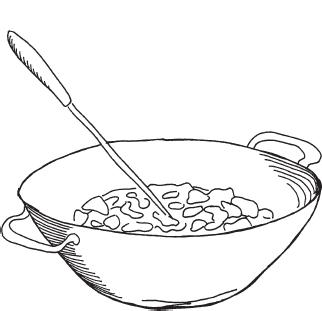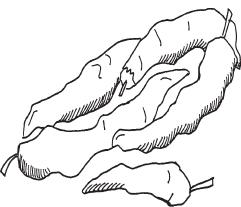Nourishing Traditions: The Cookbook That Challenges Politically Correct Nutrition and The... (95 page)
Authors: Sally Fallon,Pat Connolly,Phd. Mary G. Enig
Tags: #Non-Fiction, #Reference, #Science, #Health

TRADITIONAL POT ROAST
Serves 6-8
3 pounds rump roast, chuck roast or other cut suitable for pot roast
1 quart buttermilk (
Cultured Butter and Buttermilk
)2 tablespoons butter
2 tablespoons extra virgin olive oil
1 cup red wine
2 cups
beef stockseveral sprigs thyme, tied together
½ teaspoon green peppercorns, crushed
1 dozen small red potatoes
1 pound carrots, peeled and cut into sticks
2 tablespoons arrowroot mixed with 2 tablespoons filtered water
sea salt and pepper
In the German-speaking areas of Europe, housewives marinated beef or game several days in buttermilk before cooking it. The results are extremely tender and flavorful.
Using a needle or skewer, stick the meat all over. Place in a bowl or glass loaf pan just large enough to contain the meat and pour buttermilk over it. Allow to marinate in the refrigerator, turning occasionally, for several days.
Remove from buttermilk and dry off meat with paper towels. In a heavy, flameproof casserole, brown on all sides in butter and olive oil. Remove meat from casserole and pour out browning fat. Add wine, stock, thyme and peppercorns, bring to a boil and skim. Return pot roast to casserole and bake at 300 degrees, covered, for several hours or until tender. One hour before serving add potatoes and carrots.
Remove meat and vegetables to a platter and bring sauce to a boil on the stove. Spoonful by spoonful, add arrowroot mixture until desired thickness is obtained. Season to taste.
It has long been assumed that beef and eggs should be restricted in the diet because eggs and beef contain high levels of cholesterol.
The American Heart Association has recommended that cholesterol intake be reduced to 300 milligrams per day. The most current recommendations, however, call for dietary cholesterol levels to be reduced to even less than 300 milligrams per day, especially if one's blood cholesterol level is above 200 mg/dl.
To discover beef fat's effect on blood cholesterol levels, Reiser, a researcher, compared beef fat, coconut oil (another very saturated fat) and safflower oil (an unsaturated oil thought to be very desirable to one's health). It was found that when beef fat was added to the diet, blood cholesterol levels rose no more than when safflower oil was added.
Another researcher, according to Reiser, found that as beef fat was added to the diets of students with blood cholesterol levels of 140mg/dl, no increase in blood cholesterol could be measured. But in students with a blood cholesterol level of 190-195 mg/dl, beef fat consumption increased blood cholesterol levels to 210 mg/dl.
In another experiment, O'Brien tested the effect of red meat, fish, poultry, and three eggs daily on the blood cholesterol levels of test subjects. He found no difference in blood cholesterol levels in the test subjects regardless of which of the above foods they ate.
In one part of the trial, egg consumption increased blood cholesterol levels. However, in another part of the same trial eggs had no effect on blood cholesterol levels.
POT ROAST WITH CHILES
Serves 6-8
3 pounds rump roast, chuck roast or other cut suitable for pot roast
1-2 cups red wine
2 tablespoons butter
2 tablespoons extra virgin olive oil
2 cups
beef stock2 ounces dried red chiles (hot or mild)
8 cloves garlic, peeled and chopped
3 tablespoons red wine vinegar
2 tablespoons tomato paste
¼ teaspoon cinnamon
½ teaspoon dried green peppercorns, crushed
½ teaspoon dried oregano
several sprigs fresh thyme, tied together
sea salt and pepper
Marinate meat in red wine for several hours or overnight. Remove from wine and dry off well with paper towels. In a heavy, flameproof casserole, brown the meat on all sides in butter and olive oil. Transfer meat to a plate and pour out browning fat.
Remove stems and seeds from chiles. (Use rubber gloves for this.) Add all ingredients (except salt and pepper) to the casserole, bring to a boil, skim and return the roast to the pot. Bake in a 300-degree oven for several hours or until meat is tender.
Remove roast to a heated platter and keep warm in the oven. Run the sauce through a food mill. (See
A Word on Equipment
.) Return sauce to the casserole and reheat. If it is too thin, boil down for a bit; if too thick, add a little water. Season to taste. To serve, slice the beef and ladle sauce over each slice. Serve with
Mexican rice
.
Another researcher compared beef tallow to corn oil in rats. He found liver fat (usually considered bad for health) was lower in the rats which were fed beef tallow compared to those which received corn oil.
Another recent investigator found that as men on a lowfat, low-cholesterol diet increased their stearic acid consumption, blood cholesterol levels dipped by 14%. . ..
According to this researcher, many scientific reports over the years have indicated that stearic acid does not raise blood cholesterol in man, "but the idea has not been widely accepted." Stearic acid is the major component of beef fat.
Many reports can be found indicating that egg consumption in a normal diet has no effect on long term blood cholesterol levels. In addition, egg consumption has never been shown to increase death rates in persons initially free of coronary heart disease. Some of the studies showing egg consumption to have no appreciable effect on blood cholesterol levels were with men who already suffered from cardiovascular disease.
In addition, it has now been discovered that eggs contain substantially less cholesterol than once thought (220mg/egg rather that the 300 mgs they were believed to have.) Chris Mudd
Cholesterol and Your Health

SIMPLE LAMB CHOPS
Serves 4
8 lamb rib chops, about ½-inch thick
1 cup unbleached flour
1 teaspoon salt
1 teaspoon pepper
Dredge lamb chops in a mixture of flour, salt and pepper. Place on a broiler pan and bake at 400 degrees for about 20 minutes, turning once.
The Congressional Record pointed out that Frederick Stare, professor of nutrition at Harvard, has accepted research funds from various food manufacturers. The Congressional Record said that food processing companies pay him a large personal salary for consulting with their boards of directors. Dr. Stare was at that time on the board of directors of food companies that put sugar in their canned beans. Which is Dr. Stare going to advocate, red meat or his company's sugar-laced canned beans? How do you think he will advise congressional committees asking his advice? H. L. Newbold, MD
Type A Type B Weight Loss Book
LAMB CHOPS WITH SAUCE
Serves 4
8 lamb chops
about 1 tablespoon cracked pepper
½ cup dry red wine
2 to 3 cups
beef stock
or
Lamb Stock1 tablespoon gelatin (See
Sources
), optionalsea salt
You will need a very well-seasoned, cast-iron skillet for this recipe. Season the lamb chops with cracked pepper. Place the skillet over a moderately high fire. When it is hot, set four lamb chops in the pan. (No fat is required. The lamb chops will render their own fat, enough to keep the chops from sticking.) Cook about 5 minutes to a side, or until they are rare or medium rare. Keep in a warm oven while you are cooking the second batch and preparing the sauce.
Pour the grease out of the pan and add red wine, stock and optional gelatin. Bring sauce to a rapid boil, stirring with a wooden spoon to scrape up any accumulated juices. Boil vigorously until the sauce reduces to about ¾ cup, skimming occasionally. The sauce should be the consistency of maple syrup. Season to taste.
Place the lamb chops on heated plates, with their accompanying vegetables, and spoon on the sauce. This is excellent with
rosemary potatoes
.
EASTER DINNER
LEG OF LAMB
Serves 6
1 small leg of lamb
3 tablespoons butter
3 tablespoons Dijon-type mustard, smooth or grainy
1 onion, peeled and sliced
3 cloves garlic, peeled
several sprigs fresh thyme, rosemary or tarragon
a meat thermometer
12 new potatoes
½ cup dry white wine or vermouth
3-4 cups
beef stock
or
lamb stock1 tablespoon gelatin (See
Sources
), optionalsea salt
Peel the garlic cloves but leave them whole. Place garlic and onion in a stainless steel roasting pan. Set the leg of lamb, fat side up, on a rack in the pan. Melt butter with mustard, mix thoroughly and brush on the lamb. Place sprigs of herbs on top and insert the meat thermometer. Set in an oven preheated to 450 degrees and reduce heat immediately to 350 degrees. Cook until the thermometer registers rare or medium rare, about 15 minutes to the pound. One-half hour before the roast finishes, strew the potatoes around the roast on the rack.
Remove the roast, set on a heated platter and keep warm in the oven while finishing the potatoes and making the sauce. Remove the rack. Cut potatoes in half and place cut side down in the drippings. Bake another 15 minutes or so until the potatoes are soft. Transfer them to the heated platter. Pour wine, stock and optional gelatin into the pan and bring to a rapid boil, stirring with a wooden spoon to scrape up any accumulated juices. Boil until the sauce reduces to about 1 cup, skimming occasionally. Season to taste.
Use leftovers to make
leftover leg of lamb soup
.Variation: Leg of Lamb with Apricot Sauce
Using scissors, snip
½ cup dried unsulphured apricots
into strips. Soak in
½ cup red wine
for several hours. Add this to the sauce, omitting white wine. Serve with
winter root medley
.